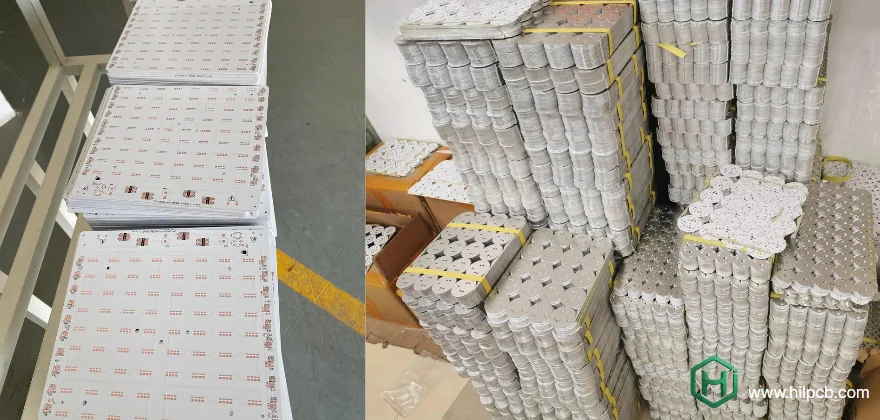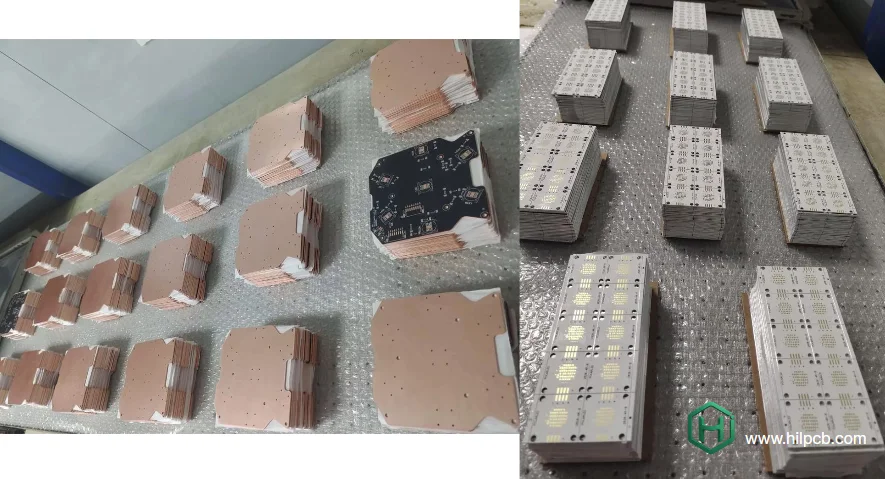As electronic systems evolve toward higher power output, tighter integration, and miniaturized designs, effective heat dissipation has become a critical factor in product reliability. Metal-core PCBs (MCPCBs) have emerged as a key technology for managing thermal challenges in demanding environments such as power electronics, automotive systems, and LED applications.
HILPCB provides complete PCB manufacturing and assembly services, with advanced capabilities that include metal-core, FR4, HDI, and rigid-flex board fabrication. Our engineering teams integrate thermal modeling, precision fabrication, and assembly validation to ensure every product meets high mechanical and electrical reliability standards. Whether for prototype evaluation or large-scale production, we deliver boards engineered for durability, heat efficiency, and consistent quality.
1. What Makes Metal-Core PCBs Unique?
A metal-core PCB replaces the traditional FR4 base with a conductive metal substrate, significantly improving heat dissipation. Typical MCPCB layers include:
- Metal Base Layer – Aluminum, copper, or steel providing thermal conduction and rigidity.
- Dielectric Layer – Thin insulation (50–200µm) with 1.0–8.0 W/mK thermal conductivity.
- Copper Circuit Layer – Conductive traces for signal and power routing.
Unlike single and double-layer PCBs on FR4, MCPCBs often feature components mounted directly over the metal base, enabling faster heat transfer and improved reliability.
Surface finishes such as HASL, ENIG, OSP, and immersion silver protect copper traces and ensure solderability for SMT assembly.
2. Substrate Materials and Thermal Characteristics
Choosing the right metal substrate is key to optimizing performance, cost, and mechanical stability.
- Aluminum Core – The industry standard for thermal management. Alloys like 5052 and 6061 offer 120–230 W/mK conductivity with low weight and cost efficiency — ideal for LED lighting and general electronics.
- Copper Core – Provides up to 400 W/mK thermal conductivity for ultra-high-power or RF systems. Common in high-thermal PCBs and RF amplifiers.
- Steel Core – Adds mechanical strength and magnetic properties, suitable for automotive and industrial electronics where rigidity is crucial.
- Hybrid Structures – Combine aluminum bases with copper inserts or HDI PCB stack-ups for localized heat spreading and higher routing density.
Material selection balances thermal performance, structural integrity, and manufacturability — factors that define long-term reliability.
3. Metal-Core PCB Fabrication Process
The metal-core PCB fabrication process involves precision manufacturing techniques that differ significantly from conventional FR4 board production. Each stage plays a crucial role in achieving stable thermal conductivity, mechanical reliability, and electrical performance.
1. Substrate Preparation Production begins with the preparation of the metal base—commonly aluminum, copper, or steel. Each sheet is cleaned, degreased, and chemically treated to improve dielectric adhesion. For aluminum substrates, anodizing or micro-etching is applied to enhance oxide stability and surface roughness. Proper preparation ensures strong bonding between layers and stable thermal transfer throughout the board’s lifecycle.
2. Dielectric Lamination The dielectric layer, which serves as the thermal interface between the metal base and copper circuitry, is laminated under controlled temperature and pressure using vacuum lamination systems. Precise pressure eliminates voids and ensures uniform dielectric thickness (typically 50–200 µm). The thermal conductivity of this layer—ranging from 1 to 8 W/m·K—directly determines the board’s heat dissipation capability.
3. Copper Foil Lamination and Circuit Imaging Once the dielectric layer is secured, copper foils (35–350 µm) are laminated and patterned through high-resolution photolithography. Precision etching produces fine-line traces down to 75–100 µm, comparable to high-frequency PCB technology. This stage defines the signal integrity and thermal pathways crucial for high-power and RF applications.
4. Drilling and Via Formation MCPCBs require special tooling to handle metal substrates without deformation. Carbide or diamond-coated drills are used to achieve clean hole walls, while laser drilling enables microvias and blind vias that connect circuit layers to the metal base for enhanced thermal conduction. Thermal vias may be filled with conductive compounds to further improve heat dissipation.
5. Solder Mask and Surface Finishing A high-temperature solder mask is applied to insulate copper circuitry and protect against oxidation. Surface finishes such as ENIG, OSP, or immersion silver ensure excellent solderability and corrosion resistance during SMT assembly.
6. Final Inspection and Testing Each manufacturing stage is monitored through statistical process control (SPC) to guarantee repeatable precision. Final verification includes electrical continuity testing, dielectric breakdown testing, and thermal resistance measurement. Boards are then cleaned, baked, and vacuum-sealed for secure shipment to the assembly stage.
By following these controlled steps, HILPCB ensures every metal-core PCB delivers exceptional layer adhesion, low thermal impedance, and consistent reliability for demanding LED, automotive, and power-electronics applications.

4. Quality Assurance and Reliability Testing
Quality defines MCPCB performance. Professional factories conduct comprehensive validation across three categories:
- Electrical Tests – Continuity, isolation, and high-voltage insulation verification.
- Thermal Tests – Thermal resistance measurement and infrared imaging under load.
- Mechanical Tests – Peel strength, thermal cycling (-40°C to +150°C), and vibration durability.
Thermal performance validation is especially critical, ensuring efficient heat transfer from active components to the substrate — a key differentiator versus standard FR4 boards.
5. Design and Application Optimization
Metal-core PCBs (MCPCBs) are widely used across industries requiring advanced thermal management and mechanical reliability. Applications include:
- LED Lighting Systems – High-brightness LED modules, floodlights, automotive headlights, and display backlights.
- Power Electronics – Converters, inverters, power amplifiers, chargers, rectifiers, and motor drives.
- Automotive Electronics – Engine control units (ECU), battery management systems (BMS), lighting systems, and onboard chargers.
- Industrial Equipment – Power controllers, variable-frequency drives, sensors, and process automation modules.
- Telecommunication Hardware – Base stations, RF amplifiers, and high-frequency power modules requiring aluminum or copper core substrates.
- Medical Devices – Diagnostic imaging systems, patient monitoring equipment, and precision surgical instruments.
- Consumer Electronics – Audio amplifiers, power adapters, gaming devices, and high-power home appliances.
- Aerospace and Defense Systems – Avionics modules, radar units, power converters, and control systems with high vibration resistance.
For complete manufacturing needs, full-service providers like HILPCB deliver both turnkey assembly and box-build assembly, combining PCB fabrication, assembly, testing, and enclosure integration under one quality system — enabling consistent performance from prototype to mass production.
6. Integrated Manufacturing and Assembly Services
A true metal-core PCB manufacturing service extends beyond bare board fabrication.
At HILPCB, our integrated workflow includes:
- MCPCB fabrication for aluminum, copper, and hybrid designs.
- Automated SMT and through-hole assembly.
- Thermal interface material (TIM) application and heat sink integration.
- Functional, electrical, and thermal testing for full validation.
This one-stop manufacturing approach eliminates cross-vendor handoffs, shortens lead times, and ensures total quality consistency from design to delivery.
Conclusion
Metal-core PCB manufacturing underpins the future of high-performance, thermally efficient electronics. By integrating advanced materials, precision fabrication, and robust testing, MCPCBs deliver the heat management and durability required in today’s power-intensive designs.
HILPCB provides complete MCPCB solutions — from material selection to assembly and testing — helping clients achieve unmatched performance, reliability, and efficiency. Whether for LED modules, automotive control systems, or industrial power supplies, our metal-core PCB manufacturing services transform complex thermal challenges into dependable, production-ready results.

